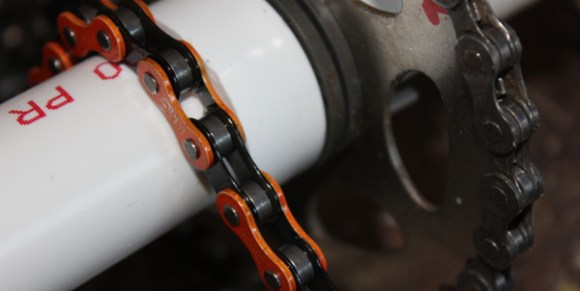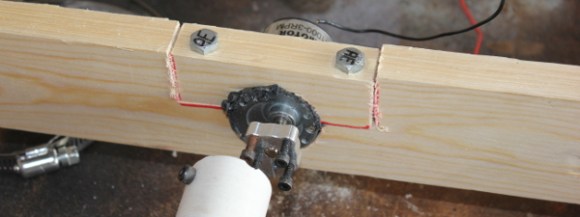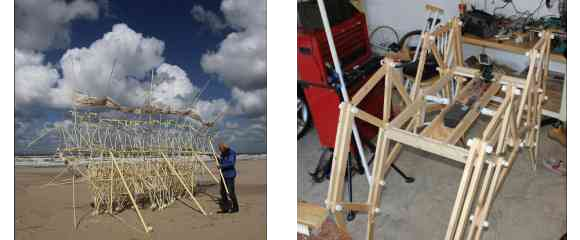About a year ago, a member of my family sent me a video featuring [Theo Jansen’s] StrandBeest, knowing that I was interested in all kinds of wacky and hackish inventions. My initial reaction was something to the effect of “wow that’s a neat device, but that guy is a little crazy.” For better or worse, the idea that this was an incredible invention turned over in my head for some time. Eventually, I decided that I needed to build one myself. Apparently I’m a little crazy as well.
Theo’s original beest runs on a complicated linkage system powered by wind. He was nice enough to publish the linkage lengths or “eleven holy numbers,” as he calls him at the bottom of this page. He doesn’t, however, really explain how the connections on his PVC power transmission system work, so I was left to try to figure it out from his videos. As you’ll see from build details and video to follow, this isn’t trivial. Keep reading past the jump to learn the adversity that I encountered, and how it was overcome in the end.
[vimeo 71927604 w=580]
The Build Begins
For reasons that I’m not entirely sure of, I started building the leg linkages out of wood instead of PVC pipe. Perhaps it was this four-legged miniature Jansen-style walker that inspired it. Some of the linkages were scaled directly from this design. That’s also likely how I decided that it might be possible to walk my StrandBeest version around with four legs. That or possibly this awesome simulation. Given how much effort it took to make each leg, the fewer the better from the perspective of getting it finished.
To begin with, I was never sure I’d finish more than one leg, but after trying out the process on the first linkage set, as seen on [HAD], soon I was testing two legs. Finally it was on to four legs linked together with a central PVC shaft — also seen on [HAD] and in the video below.
[youtube http://www.youtube.com/watch?v=WwnvAjFfxOs w=580]
I thought that was pretty cool, so the build seemed to be done for the time being. I literally hung it up in my garage to see if I could think of anything better to do with it.
Inspiration to Finish the Project
Months later, I was contacted by [Jay], who recruits for the Columbia, SC Maker Faire, about doing something for the show. My dormant ‘Beest, now dubbed the [MountainBeest], seemed like a great candidate. [Jay] volunteered that they had a winch available (why not?) to hoist the [MountainBeest] up and down spider. This was great, as I had serious doubts about its ability to walk on its own.
Although I could have probably hooked up a series of cables to actuate the legs remotely, this didn’t seem quite good enough. Electronic remote control seemed like a better idea, and fortunately I had a windshield wiper motor and controls left over from a failed “giant hexapod” project that [HAD] featured in 2012.
Some Issues with the Build

The mechanical build was simple enough, but power transmission with PVC pipe is getting into somewhat uncharted waters for me. My first idea was to use sprocket gears off of a bike that I converted to single speed, and windshield wiper motors to power the legs. This idea had some potential, but I was supporting the driving gear quite poorly. Additionally, the wiper motors tended to go faster and start more violently than the [MountainBeest] liked. As seen here, even after upgrading to a larger single speed chain, things didn’t stay together.
[youtube http://www.youtube.com/watch?v=mf25dZ4U-Ws w=580]
My “custom” single speed bike, however, looks awesome with its new chain. It’s good to have a backup plan.
The [MountainBeest] backup plan was to use one slower motor on each set of two legs. This would get rid of any pesky chain issues, and theoretically allow the ‘beest to turn when walking. It took some work, including modifying the frame and coming up with an interesting motor mounting solution seen in the picture below. It did work, however, and that counts a success in HaD land.

One continuing issue I’ve had with the extremely low geared motors I was using, is that at certain points in the mechanism’s travel, it tends to put a huge amount of torque on the shaft. In order to fight this, I came up with a PVC coupler that absorbs some shock and allows it to flex as seen on [HAD] here. These are known in their more traditional settings as a “beam” or “helical” coupling. My PVC version is seen in the video below.
[youtube http://www.youtube.com/watch?v=xZzkBMySk94 w=580]
Final Design
After solving (or at least mitigating) most of the mechanical issues with my “walker,” the electronics were fairly simple. I used a four-channel radio transmitter with a PWM relay switch from Servocity. This was able to handle the DC motors nicely, despite possibly being overkill. After wondering what I could do with the other two channels, I remembered that I had a Pan/Tilt mechanism already built.

After attaching the camera mount to the polycarbonate shell, it was simply a matter of plugging the servos in. In a few easy steps I had a ready-made GoPro mount to add sight to my creation!
Below is a video of it completed in the garage, and there’s more information on the final build here. Unfortunately, the torque required to actually make the legs walk was too much for the little motors I was using. It’ll make a great display though, and actually walking will be a good goal if I ever decide to make revision 1!
[youtube http://www.youtube.com/watch?v=_yS6Ixjgb_A w=470]
So sometimes one just needs a little push to actually finish a project! Hopefully my [MountainBeest] can make a good showing at the Columbia, South Carolina Maker Faire this year. I’m certainly looking forward to it. If you happen to be in the area on June 14th this year, or want to make the trip, be sure to stop by and say hello!
Full disclosure: I’ve received promotional consideration on some parts used in this project not in connection with this article.
 Jeremy Cook is a manufacturing engineer with 10 years experience as his full-time profession, and has a BSME from Clemson University. Outside of work he’s an avid maker and experimenter, working on everything from hobby CNC machinery, to light graffiti, and even the occasional DIY musical instrument. When he’s not busy creating (or destroying) something, he writes for his blogs JcoPro.net and DIYTripods.com.
Jeremy Cook is a manufacturing engineer with 10 years experience as his full-time profession, and has a BSME from Clemson University. Outside of work he’s an avid maker and experimenter, working on everything from hobby CNC machinery, to light graffiti, and even the occasional DIY musical instrument. When he’s not busy creating (or destroying) something, he writes for his blogs JcoPro.net and DIYTripods.com.
















I dont get it. Theo Jansen’s Models work great. He had a bright idea to achive his idea of self moving creatures. So what is Jeremys approach? His Model looks extremely fiddled, patched up and with lots of work arounds. He uses an underdimensioned Motor to barely move a leg while the original worked without a Motor at all. So what is the broad vision of this? I dont get it.
I’m not a fan of his work-around-attitude in this project. He is going backwards with this.
I couldn’t have said it better, I’m confused as well…
I have not given these type of machines a terrible lot of thought but here is my armchair impression:
The original is performing better because of two reasons that I can see. More legs have caused the torque to be much smoother, like having more pistons in an engine. The peak torque of picking the 1 leg up is lost in that mess.
Secondly, that torque is coming from other legs, not from a central motor. The original is powered by a large wind sail which pushes the whole thing, so the feet that are touching the ground are doing the work. So we don’t really know what the numbers are but they seem to balance out ok, the leverage and weight of a leg being picked up is the same as the leg that’s moving it. Or maybe just because of the high qty of them the works is more spread out.
It’s hard to tell if that peak torque is avoidable or not, perhaps if the stride was not so long it would be easier to deal with? That would be a leg rebuild though.
I would review the joints to make sure nothing is actually binding, and consider counterweights on the leg levers since there’s only 4 of them. I also want to see what happens if he just sets it down and gives it a push if it will walk along like the wind powered one does.
Not everyones a pro, dude looks like hes fucking around in his garage having a good time. I dont really understand peoples confusion. it is what it is.
Over the past 10 years an equivalent thing happened with music: cheap computers and recording equipment yielded lots more content, but a proportionally equivalent amount of garbage.
This guy is replicating something cool for pretty cheap, but his motors are at LEAST an order of magnitude too small. He needs to channel his inner Tim “The Tool Man” Taylor and just go big.
Ha, thanks for understanding! Not sure why all the criticism on a site called “Hack a Day,” but that’s how comments go I suppose.
Gearing system with a properly aligned axle point would probably help this out. The misalignment of the current system is putting a good deal of stress on the motor I imagine. It’s missing the smooth movement of the actual Stranbeest.
what someone with the time and resources needs to do is build a beest… that one sits in and pedals as a bike. a ride in hexapod style deal? you could add wing and a motor later on for additional speed/ distance too.
Really a great idea… Man, I’d love to build one like that – I’ll definitely have to upgrade my design though!
Here’s a miniature one powered by a hamster:
http://www.youtube.com/watch?v=A3iP0NGDDao
He should call it BergBeest. Berg is dutch for mountain.
That does sound pretty good!
Some are criticizing this effort by comparing it to Theo Jansen’s finished beests. You can bet that Jansen went through this same stage of development long before he had self-powered monsters roaming the beaches. Prototypes are messy learning tools.
I’m sure that’s true. I’m just glad to have it somewhat functional! Really, I mostly enjoy the process, which is what I’d hoped to get across in this post.
The major problem with these things is steering. I want to see one with 6 individually controllable legs, a driver’s seat and have it able to make turns and operate on non-flat terrain.
At least 6 legs will be needed for a self-stable version, or something like a racing sulky https://en.wikipedia.org/wiki/Harness_racing attached well enough to keep a 4 leg one upright while it pulls the rider.
Firstly, for all the haters, he is actually DOING something, trying things to see if he can figure something out on his own. Good for him. You learn FAR more from analyzing your failures than from your successes.
Secondly, torque can be absorbed by transferring power through a spring wrapped around a sliding shaft, where the motor itself is on a sliding (unkeyed) mount. Under sudden high load, the spring will contact/expand, smoothing the output.
i want to ask some question…
how can you calculated all of the foot length??
I really curious, because i want to use this theory into my next project…
i hope you can answer me, because i really really really curious…
thanks..